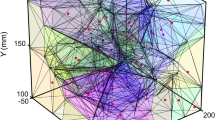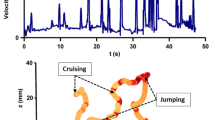Abstract
Longitudinal dispersion of multiple Microcystis patches is significant for understanding the mechanisms of Microcystis blooms in ambient waters. Presented in this paper is an analysis of multiple Microcystis patches in a turbulent open channel flow, based on the concentration transport equation. Results show that the total amount of Microcystis on a streamline, centre-of-mass motion, as well as longitudinal dispersion finally stabilise for multiple Microcystis patches as they do for a single Microcystis patch. The centre-of-mass velocity exhibits a weak oscillation with a small amplitude in the vertical direction for multiple Microcystis patches, but it can reach the same migration velocity for long time evolution. The large \(\mathrm{Pe}_z\) results in an asymptotic increase of centre-of-mass velocity towards a positive value except for very early time for the Microcystis patches in close proximity to the free surface, and an initial reduction to zero, subsequent increase to a maximum, and final decrease to a constant for the bed bottom, where \(\mathrm{Pe}_z\) represents the relative strength of vertical swimming and the total effective diffusion in the vertical direction. For the case of large \(\mathrm{Pe}_z\), the longitudinal dispersion coefficient first increases to a maximum, then decrease to a minimum, and finally increases to a constant for the Microcystis patches near the free surface. The effects of initial distribution on the evolution of the concentration of Microcystis patch mainly appear during the initial stage and can be negligible for the long time evolution. The Microcystis patches tend to accumulate near the free surface due to the vertical migration velocity caused by density differences between the Microcystis and the ambient water.









Similar content being viewed by others
References
Aris R (1956) On the dispersion of a solute in a fluid flowing through a tube. Proc R Soc Lond A 235(1200):67–77
Chatwin PC (1972) The cumulants of the distribution of concentration of a solute dispersing in solvent flowing through a tube. J Fluid Mech 51(1):63–67
Croze OA, Bearon RN, Bees MA (2017) Gyrotactic swimmer dispersion in pipe flow: testing the theory. J Fluid Mech 816:481–506
Elder JW (1959) The dispersion of marked fluid in turbulent shear flow. J Fluid Mech 5(1):63–67
Gill WN (1967) A note on the solution of transient dispersion problems. Proc R Soc Lond A 298(1454):335–339
Gill WN, Sankarasubramanian R (1970) Exact analysis of unsteady convective diffusion. Proc R Soc Lond A 316(1526):341–350
Guan MY, Zeng L, Li CF et al (2021) Transport model of active particles in a tidal wetland flow. J Hydrol 593(125):812
Guo J, Jiang W, Chen G et al (2022) Solute dispersion in an open channel turbulent flow: solution by a generalized model. J Hydrol 604(127):239
Hill NA, Bees MA (2002) Taylor dispersion of gyrotactic swimming micro-organisms in a linear flow. Phys Fluids 14(8):2598–2605
Huai WX, Zhang J, Wang WJ et al (2019) Turbulence structure in open channel flow with partially covered artificial emergent vegetation. J Hydrol 573:180–193
Huisman J, Codd GA, Paerl HW et al (2018) Cyanobacterial blooms. Nat Rev Microbiol 16(8):471–483
Jiang W, Chen G (2019) Dispersion of active particles in confined unidirectional flows. J Fluid Mech 877:1–34
Li M, Xiao M, Zhang P et al (2018) Morphospecies-dependent disaggregation of colonies of the cyanobacterium microcystis under high turbulent mixing. Water Res 159:340–348
Maier RS, Kroll DM, Bernard RS et al (2002) Enhanced dispersion in cylindrical packed beds. Phil Trans R Soc A 360:497–506
Mei CC, Auriault JL, Ng CO (1996) Some applications of the homogenization theory. In: Hutchinson JW, Wu TY (eds) Advances in applied mechanics, vol 32. Elsevier, pp 277–348
Murphy E, Ghisalberti M, Nepf H (2007) Model and laboratory study of dispersion in flows with submerged vegetation. Water Resour Res 43(5):W05,438
Nepf H, Ghisalberti M, White B et al (2007) Retention time and dispersion associated with submerged aquatic canopies. Water Resour Res 43(4):W04,422
Nepf HM (1999) Drag, turbulence, and diffusion in flow through emergent vegetation. Water Resour Res 35(2):479–489
Nepf HM (2012) Flow and transport in regions with aquatic vegetation. Annu Rev Fluid Mech 44(1):123–142
Ng CO (2006) Dispersion in steady and oscillatory flows through a tube with reversible and irreversible wall reactions. Proc R Soc Lond A 462:481–515
Qin B, Yang G, Ma J et al (2018) Spatiotemporal changes of cyanobacterial bloom in large shallow eutrophic Lake Taihu, China. Front Microbiol 9:451
Richard S (2011) China aims to turn tide against toxic lake pollution. Science 333(6047):1210–1211
Taylor GI (1953) Dispersion of soluble matter in solvent flowing slowly through a tube. Proc R Soc Lond A 219(1137):186–203
Wu X, Kong F (2009) Effects of light and wind speed on the vertical distribution of microcystis aeruginosa colonies of different sizes during a summer bloom. Int Rev Hydrobiol 94(3):258–266
Wu X, Noss C, Liu L et al (2019) Effects of small-scale turbulence at the air-water interface on microcystis surface scum formation. Water Res 167(115):091
Wu Z, Chen GQ (2014) Approach to transverse uniformity of concentration distribution of a solute in a solvent flowing along a straight pipe. J Fluid Mech 740:196–213
Wu Z, Foufoula-Georgiou E, Parker G et al (2019) Analytical solution for anomalous diffusion of bedload tracers gradually undergoing burial. J Geophys Res Earth Surf 124:21–37
Wu Z, Singh A, Fu X et al (2019) Transient anomalous diffusion and advective slowdown of bedload tracers by particle burial and exhumation. Water Resour Res 55(10):7964–7982
Wu Z, Furbish D, Foufoula-Georgiou E (2020) Generalization of hop distance-time scaling and particle velocity distributions via a two-regime formalism of bedload particle motions. Water Resour Res 56:e2019WR025,116
Wu Z, Singh A, Foufoula-Georgiou E et al (2021) A velocity-variation-based formulation for bedload particle hops in rivers. J Fluid Mech 912:A33
Yang Y, Tan S, Zeng L et al (2020) Migration of active particles in a surface flow constructed wetland. J Hydrol 582(124):523
Yang Y, Jiang W, Wu Y et al (2021) Migration of buoyancy-controlled active particles in a laminar open-channel flow. Adv Water Resour 156(104):023
Yasuda H (1984) Longitudinal dispersion of matter due to the shear effect of steady and oscillatory currents. J Fluid Mech 148:383–403
Zeng L, Chen GQ (2011) Ecological degradation and hydraulic dispersion of contaminant in wetland. Ecol Modell 222(2):293–300
Zeng L, Zhao YJ, Chen B et al (2014) Longitudinal spread of bicomponent contaminant in wetland flow dominated by bank-wall effect. J Hydrol 509:179–187
Zeng L, Wu Z, Fu X et al (2015) Performance of the analytical solutions for Taylor dispersion process in open channel flow. J Hydrol 528:301–311
Zeng L, Zhang HW, Wu YH et al (2019) Theoretical and numerical analysis of vertical distribution of active particles in a free-surface wetland flow. J Hydrol 573:449–455
Acknowledgements
This work is supported by the IWHR Research and Development Support Program (Grant No. HY0199A112021), and the Independent Research Project of State Key Laboratory of Simulation and Regulation of Water Cycle in River Basin (Grant No. SKL2022TS09).
Author information
Authors and Affiliations
Corresponding authors
Ethics declarations
Conflict of interest
The authors declare no conflict of interest.
Rights and permissions
Springer Nature or its licensor holds exclusive rights to this article under a publishing agreement with the author(s) or other rightsholder(s); author self-archiving of the accepted manuscript version of this article is solely governed by the terms of such publishing agreement and applicable law.
About this article
Cite this article
Yang, F.Y., Wang, P., Chen, X.L. et al. Longitudinal dispersion of multiple Microcystis patches in a turbulent open-channel flow. Energ. Ecol. Environ. 8, 50–61 (2023). https://doi.org/10.1007/s40974-022-00258-1
Received:
Revised:
Accepted:
Published:
Issue Date:
DOI: https://doi.org/10.1007/s40974-022-00258-1




